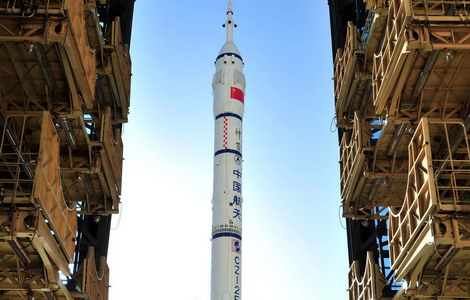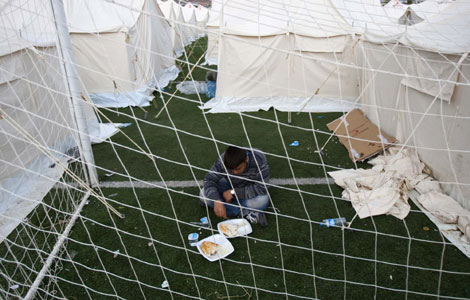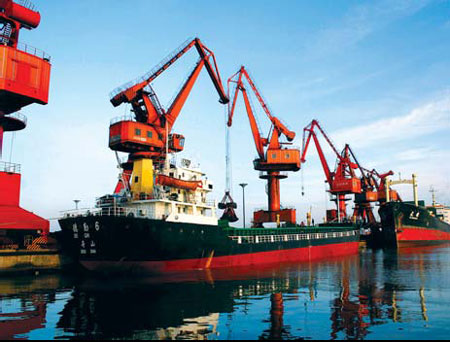Hebei: Coastal zone reforms fuel growth
Updated: 2011-10-27 08:06
By Liu Xiang (China Daily)
|
|||||||||||
|
The annual cargo throughput at Jingtang Port has exceeded 100 million tons for three consecutive years. |
Though just 52 kilometers of the planned 449-kilometer-long expressway set for completion this year, the Hebei Coastal Highway finished on Sept 26 now connects Huanghua Port with neighboring ports including Caofeidian, Jingtang, Qinhuangdao, Qingdao and Lianyungang.
The expressway will ultimately complete the transport grid connecting the province's "economic belt" with other development zones.
"Hebei is in the midst of vital transformation of its economy," said Zhang Qingwei, deputy chief of the provincial Party committee and acting governor.
Focused on the development of the area surrounding the Bohai Sea, the blueprint for coastal areas in Hebei has become a national strategy bringing unprecedented opportunities to the province, Zhang said.
Quickening pace
In mid-September, Hebei's new Party chief Zhang Qingli said during a visit to the city of Cangzhou that coastal areas should further break with conventional ideas to quicken the pace of economic reform.
Despite its coastline of 487 km and a coastal zone covering 1.1 million hectares, the area's economy lags many other regions.
In 2006, the provincial government formulated the idea to further develop the coastal zone's economy. During the 11th Five-year Plan (2006-2010), a "coastal economy circle" plan laid the foundation for later developments.
In March 2011, when the National People's Congress was held in Beijing, the proposal was officially adopted in the central government plan, becoming a part of the national strategy.
Range of efforts
To bring the proposal to reality, the provincial government carried out a range of efforts including building more ports and fostering industries that will help reform Hebei's economic structure.
In 2011, the efforts became more detailed - moving industries to Huanghua and Caofeidian, where new facilities will be located across 210 square kilometers. The investment this year is expected to surpass 80 billion yuan ($12.5 billion).
The government is also expanding and modernizing existing ports at Huanghua and Qinhuangdao.
The coastal areas at Qinhuangdao, Tangshan and Cangzhou, with 11 affiliated counties and their industrial zones, are priorities in boosting local economies.
On Sept 18, Chen Guoying, mayor of Tangshan, told the media that accumulated investment in Caofeidian Port has surpassed 300 billion yuan.
40 agreements
More than 40 agreements were reached at a recent business fair in Caofeidian that attracted more than $2.7 billion in overseas and 2.83 billion yuan in domestic investments.
The agreements are mainly for equipment manufacturing, modern logistics, new energy and electronic information that is designed to more efficiently develop shipping.
Throughput at Qinhuangdao Port has surpassed 200 million tons for six successive years.
The city of Qinhuangdao is also making efforts to boost tourism, which is already well known across the country.
In Cangzhou, local authorities built large-scale industrial parks to attract more business.
According to a range of statistics recently released by the Hebei Development and Reform Commission, the highlighted 11 counties and nine economic zones had a GDP of 140 billion yuan in the first six months of this year, a 13 percent increase over the same time last year.
Actual utilized overseas investment has now reached $660 million this year, a 4 percent year-on-year increase.
In year 2011, the coastal areas in Hebei established 1,578 projects each with a value over 100 million yuan. Of them, 414 are under construction and 399 will soon break ground.
In the first seven months, combined investment in large projects surpassed 96 billion yuan, some 78 percent of the full-year target for 2011.
Since the whole blueprint was adopted, the coastal areas in Hebei have built more than 120 industrial projects each with an investment value surpassing 1 billion yuan for a total of 590 billion yuan.
Thirty-five of the largest projects require investment exceeding 5 billion yuan. Work on 27 of them is now underway.
Objectives
Hebei's 71 million residents expect the projects will bring substantial improvements to the local economy.
According to the provincial government's plan, the gross value from the 11 coastal counties should quadruple by 2015 from the current annual 220 billion yuan to 880 billion yuan.
Local tax revenues are projected to soar from 27 billion yuan annually to 110 billion yuan.
The plan calls for coastal areas in Hebei to mainly concentrate on iron and steel production, equipment manufacturing, electronic information industry, modern logistics, financial and high-tech services, and tourism.
In preparation, a number of facilities, warehouses, business buildings and public utilities have already been developed.
More preferential policies will also be issued to support coastal areas in Hebei. Half of the allotted land for development in Hebei province from 2011 to 2015 is in Qinhuangdao, Tangshan and Cangzhou.
The financial authorities have jointly issued a regulation to enhance credit in coastal areas.
Economists in Hebei predict that coastal areas will play a more significant role in growing the overall business for the province.
(China Daily 10/27/2011 page10)
Hot Topics
Libya conflict, Gaddafi, Oil spill, Palace Museum scandal, Inflation, Japan's new PM, Trapped miners, Mooncake tax, Weekly photos, Hurricane Irene
Editor's Picks

|

|

|

|

|

|








